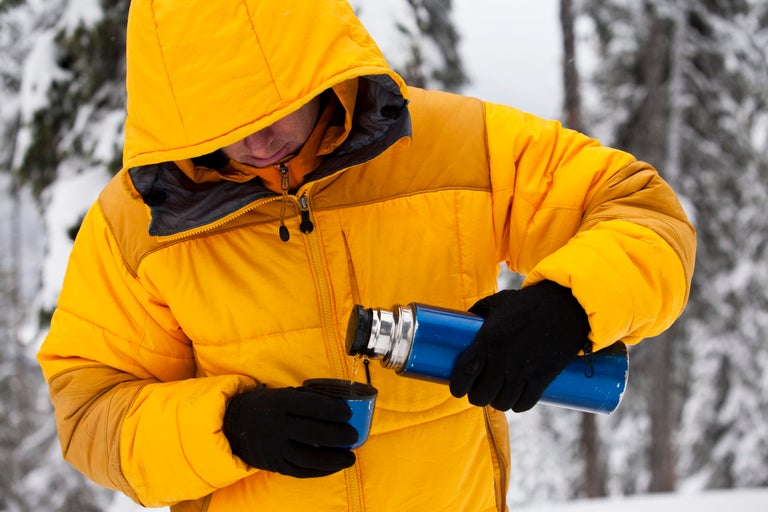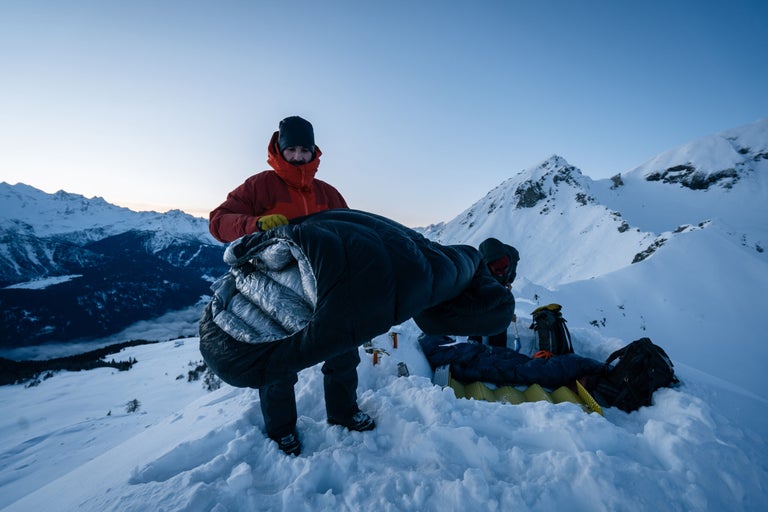An Expert’s Guide to Surviving Winter Weather
In her monthly column, The Survivalist, Jessie Krebs writes about staying alive in dangerous backcountry scenarios. Krebs is a former Air Force S.E.R.E (survival, evasion, resistance, and escape) instructor and owner of O.W.L.S. Skills.
The fear of feeling cold and losing sleep due to cold stops a lot of people from going hiking or camping in winter. On the first night of my overnight survival classes, I “tuck” my students in, visiting each shelter to give personalized advice on everyone’s sleep system. Here are my top tips for keeping toasty in the most frigid conditions.
Clothing
Keeping your clothing and equipment in good shape is important. With that being said, it’s not actually your clothes that keep you feeling warm—it’s dead air space. Clothing helps hold a layer of air near you, which your body heats up to make you feel warmer.
I remember playing out in the snow as a kid in Michigan. My feet got cold, so I put on another pair of socks, stuffed my feet into the same boots and went back out, but my feet felt even colder. I’d reduced the circulation in my feet and increased the conductivity. If I’d put on fluffy, looser socks and wore a half-size larger boot, I would have stayed warm.
There are five main ways in which we lose heat. In order to survive in the cold, I tell my students, “don’t get RRECC’d: Radiation, Respiration, Evaporation, Convection, and Conduction.”
Creating dead air space can help with all of these. I never wear winter gear that is form-fitting or tight. I want my jackets baggy, so if I start getting cold I can add layers under it, or stuff the sleeves and core with insulating debris like leaves and punk wood.

In SERE training, we used the following acronym to discuss clothing: C.O.L.D.E.R.
Keep it Clean. Dirt under a microscope looks like little pieces of glass. Get that in your clothes and every time you move it slices up the fibers. Clogging the dead air space of your clothes also means it conducts the heat away from you faster.
Avoid Overheating. If you’re sweating, you’re wasting energy and water, and when you stop you’re way more likely to go hypothermic. Survivors’ motto: If you don’t have to be moving, be standing still; if you don’t have to stand, sit; if you don’t have to sit, lay down; and if you don’t have to be awake, be asleep. Slow, deliberate movement is what we’re after in a survival situation.
Loose and layered clothes create dead air space and allow us to dress up and down based on the weather and our activity level.
Dry your clothes as soon as possible if they get wet. We sweat to cool down for a reason. If it’s cold or it’s going to be cold within an hour or two, do your best to stay dry. If you do get wet, there are multiple techniques for drying things out, even without a fire. Powdery snow, for example, can act like a sponge to wick moisture from cloth. You can wear damp clothes and move until you generate enough heat to dry them out. I recommend curling up in the fetal position inside your sleeping bag (or improvised sleeping bag) and clenching your muscles for a few seconds, then relaxing. Repeat this over and over to generate heat without moving excessively.
Examine what’s working and what’s not. If you have a white jacket and a dark sweatshirt on a sunny but very cold day, see if the sweatshirt will fit over the jacket to help you gather more radiant light. Hands cold? Improvise a muff or gloves.
Repair problems ASAP. Most of us SERE instructors keep a threaded sail needle in our hat so if a seam opens or someone tears their clothes we can quickly stitch it up. It’s hard to thread a needle in cold weather.
Sleep Systems

There is such a thing as too much dead air space. If I sit naked in a sealed 6-square-foot room on a frozen lake, I’m not going to be warm. There is too much space for my little body to heat up. The same principle applies to sleep systems, which can be your ticket to surviving in the cold. Don’t be afraid to get creative: At one point, I was issued a sleeping bag that was designed for someone much taller and larger than me. To reduce the volume of dead air space, I turned it inside out, tied a line around the bottom section of the bag, then turned it back right side out. Now it fit my length better and had a fluffy “pillow” at my feet. Then I took my rain gear, zipped up the jacket, turned it inside out, and slipped it over the foot of my bag so it came up to about mid thigh. That pulled in the sides to make a still loose-fitting but comfortably snug area around my feet and legs that stayed deliciously warm.
In a survival situation, you can’t afford to deal with a popped, leaky, or too-cold inflatable sleeping pad. I’ve used a single closed-cell foam sleeping pad between me and the ground for years. They are foolproof, and come in handy in situations where inflatables can fail, like around a fire with flying embers or on rough ground. You’ll never have to worry about patching your foam pad, which can be especially tricky in cold weather (glue and freezing temperatures don’t often mix).
Plus, inflatables can have too much dead air space that traps cold—especially uninsulated or lightly insulated pads made for warm weather. Ever sleep on those inflatable mattresses as a guest in someone’s home? It can get chilly. If you like the softness of a nice thick inflatable pad, look for one with a high R-value or top it with a thin non-inflatable pad for warmth. Just remember that while inflatables might work fine for a regular winter camping trip, a foam pad is most reliable if you find yourself in a high-stakes survival situation.
Hydration
Staying hydrated is key to surviving in the cold. Most water filters are useless in freezing temps. They freeze up and can’t filter or form micro cracks that ruin them. Learn which water sources in winter do not need to be disinfected, and make sure you have chemical purification available for those that do.
If you fill your water bottles to the top and then they freeze, they are likely to break or bulge. Leave an inch or so of air space. If you don’t want to or can’t sleep with them (there is danger of hypothermia if they leak into your sleeping bag) then there are techniques to keep them from freezing solid. Add some hot water to the container if possible. Flip the sealed container upside down (to help keep the lid from freezing shut) and bury it in about a foot of snow or bulky insulative material.
Electronics
Freezing temperatures can degrade or destroy most batteries. This can be dangerous in a survival situation when you need your electronics to navigate or signal for help. Remove the batteries from your devices when possible and keep both next to your body. The next best option is to keep your devices off and keep them warm (this means sleeping with your electronics). The least you can do is keep just the batteries warm and put them back in just when you want to use the device.
